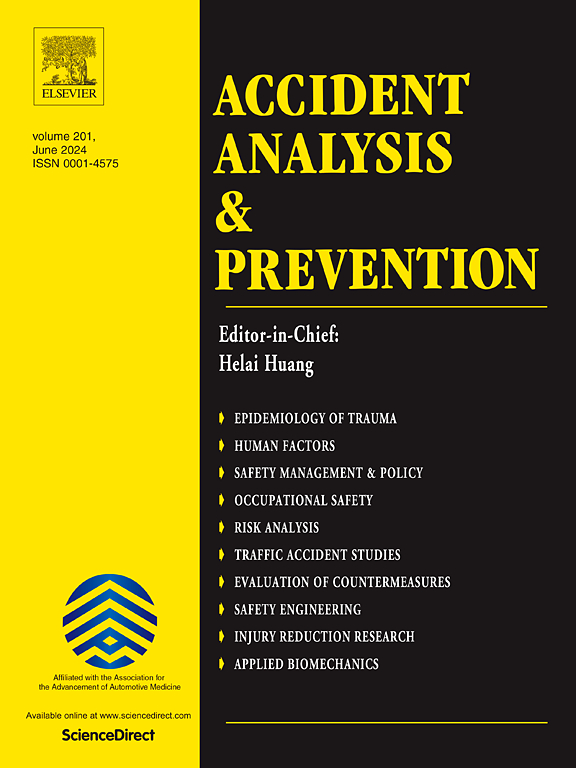线上安全:利用VR技术研究人行横道设计对儿童感知安全、谨慎行为和视觉注意力的影响
IF 6.2
1区 工程技术
Q1 ERGONOMICS
引用次数: 0
摘要
虽然儿童在过马路时特别容易发生事故,但关于他们对人行横道设计和条件的具体感知和行为反应的知识是有限的。通过模拟虚拟现实(VR)实验,本研究调查了178名年龄较小(8-10岁)和较大(11-12岁)的儿童及其父母在学校区域无信号t型路口的环境如何影响感知安全性、过马路行为和视觉注意力。使用再现虚拟实验数据(carving)技术对观看场景进行比较,从交叉分类多层次、轨迹和反事实分析中得出的主要发现如下。首先,尽管孩子们的身体和认知能力有限,但他们——尤其是年幼的孩子——在人行道和公路上表现出的注意力更少,而且比父母的非正式穿越率更高。第二,对环境条件的反应因发育阶段而异。虽然年龄较大的儿童和父母通常对危险条件的反应更加谨慎,但年龄较小的儿童表现出最小的行为调整。例如,父母认为停车的环境不太安全,在道路上表现出更多的关注和预防行为。相比之下,年幼的儿童,尽管他们的视线受到阻碍,但未能认识到这些危险,也没有采取补偿策略,从而加剧了他们的脆弱性。同样,只有年龄较大的孩子和家长认为装饰性的人行横道图案比传统的更不安全。第三,虽然传统的人行横道促进了正交交叉,并为更安全的行动提供了更清晰的指导,但装饰图案往往鼓励对角线和分散的交叉,导致更高的乱穿马路率。最后,速度限制对感知安全或交叉行为没有显著影响。这些研究结果强调了发育阶段对安全认知和行为的重要影响,强调了重新评估人行横道设计和解决非法停车造成的能见度挑战的必要性,以提高儿童行人安全。本文章由计算机程序翻译,如有差异,请以英文原文为准。
Safety on the Line: Examining the impacts of crosswalk design on Child’s perceived Safety, cautious Behavior, and visual attention with VR Technology
Although children are particularly vulnerable to accidents while crossing a street, knowledge about their specific perceptual and behavioral responses to crosswalk design and conditions is limited. By employing simulated virtual reality (VR) experiments, this study investigated how the environment of an unsignalized T-junction in a school zone influenced the perceived safety, crossing behaviors, and visual attention of 178 participants, consisting of younger (aged 8–10) and older children (aged 11–12) and their parents. Key findings from cross-classified multilevel, trajectory, and counterfactual analyses using Reproduced Virtual Experiment Data (CARVED) techniques for viewed scene comparisons are as follows. First, despite their physical and cognitive limitations, children—particularly younger ones—exhibited fewer attentive behaviors on sidewalks and roadways, along with a higher informal crossing ratio than parents. Second, responses to environmental conditions varied by developmental stage. While older children and parents generally responded to hazardous conditions with increased caution, younger children exhibited minimal behavioral adjustments. For example, parents perceived environments with parked cars as less safe and demonstrated more attentive and preventive behaviors on roadways. In contrast, younger children, despite having their line of sight obstructed, failed to recognize these hazards and did not adopt compensatory strategies, reinforcing their vulnerability. Similarly, only older children and parents perceived decorative crosswalk patterns as less safe than traditional ones. Third, while traditional crosswalks facilitated orthogonal crossings and provided clearer guidance for safer movements, decorative patterns often encouraged diagonal and dispersed crossings, resulting in a higher jaywalking ratio. Lastly, speed limits showed no significant influence on perceived safety or crossing behaviors. These findings highlight the critical influence of developmental stages on safety perceptions and behaviors, emphasizing the need to reassess crosswalk designs and address visibility challenges caused by illegal on-street parking to enhance child pedestrian safety.
求助全文
通过发布文献求助,成功后即可免费获取论文全文。
去求助
来源期刊

Accident; analysis and prevention
Multiple-
CiteScore
11.90
自引率
16.90%
发文量
264
审稿时长
48 days
期刊介绍:
Accident Analysis & Prevention provides wide coverage of the general areas relating to accidental injury and damage, including the pre-injury and immediate post-injury phases. Published papers deal with medical, legal, economic, educational, behavioral, theoretical or empirical aspects of transportation accidents, as well as with accidents at other sites. Selected topics within the scope of the Journal may include: studies of human, environmental and vehicular factors influencing the occurrence, type and severity of accidents and injury; the design, implementation and evaluation of countermeasures; biomechanics of impact and human tolerance limits to injury; modelling and statistical analysis of accident data; policy, planning and decision-making in safety.
 求助内容:
求助内容: 应助结果提醒方式:
应助结果提醒方式:


